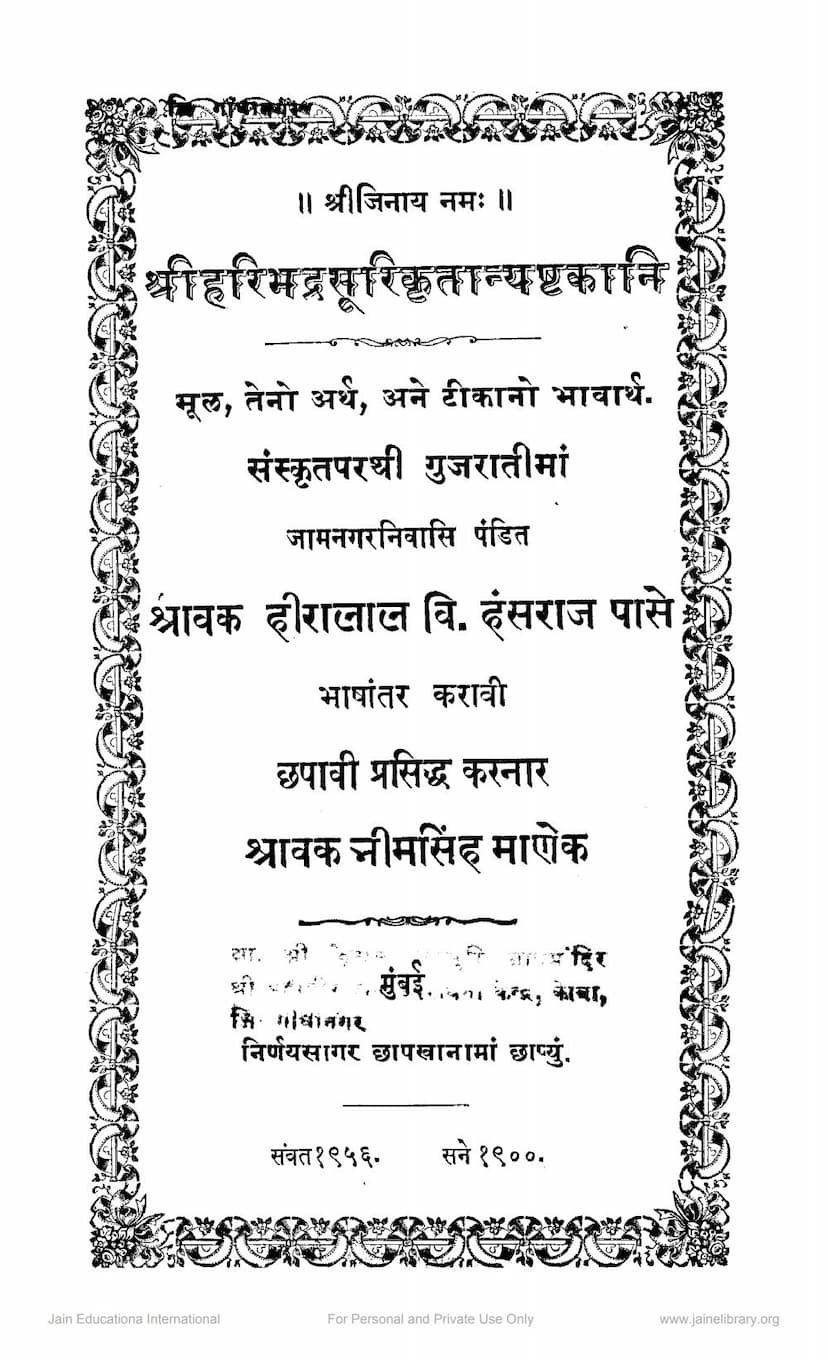Haribhadrasuri Krutanyashtakani
Added to library: September 1, 2025

Summary
Here's a comprehensive summary of the Jain text "Haribhadrasuri Krutanyashtakani" (Haribhadrasuri's Ashtakas) based on the provided Gujarati text:
Book Title: Haribhadrasuri Krutanyashtakani (The Ashtakas Composed by Haribhadrasuri) Author(s): Shravak Bhimsinh Manek (compiler/publisher) Publisher: Shravak Bhimsinh Manek Catalog Link: https://jainqq.org/explore/003686/1
Overall Purpose and Content:
This book presents a Gujarati translation and commentary of the "Ashtakas" (collections of eight verses) composed by the renowned Jain Acharya Haribhadrasuri. The primary aim is to make these profound Jain texts accessible to the Gujarati-speaking community, providing the original Sanskrit verses, their Gujarati meaning, and the essence of the commentary.
Key Highlights:
-
The Author, Haribhadrasuri:
- Acharya Haribhadrasuri was a great scholar who lived in the 5th century Vikram Samvat.
- He is credited with composing a vast number of works (around 1444).
- He was originally a learned Brahmin who, upon witnessing violence and hypocrisy in existing religious practices, embraced Jainism.
- His works are extensive and demonstrate profound knowledge. Some of his notable works mentioned include: Anekanjaypataka, Shishyhita (commentary on Avashyak Sutra), Upadeshpad, Jammudeeva Sangrahani, Dashavaikalik Niyukti Teeka, Samaraaditya Charitra, Yoga Bindu Prakaran Vritti, and the Ashtakas.
- His compositions are often marked by the word "Virah" (meaning separation or absence, likely referring to the absence of flaws or the transcendence of worldly attachments), which serves as a signature for his works.
- He is believed to have attained liberation (Devlok Gaman) in 535 Vikram Samvat.
-
The Commentators:
- Shri Jineshwarsuri: He composed the commentary on the Ashtakas. He lived in the 10th century Vikram Samvat and was a disciple of Shri Vardhamanasurishwarji. He was the guru of Shri Abhaydeva Suri, Shri Jinchandsuri, and Shri Jinbhadra Suri. Originally a Brahmin named Shiva, he was known for his sharp intellect. He earned the title "Khartar" after winning a religious debate with the Chaityavasis in Gujarat during the reign of King Durlabhsen. He completed the commentary on the Ashtakas in 1000 Vikram Samvat in the village of Jawalpur.
- Shri Abhaydeva Suri: He refined and edited the commentary. He was also alive in the 10th century Vikram Samvat and was a disciple of Shri Jineshwarsuri. His birth name was Abhaykumar, and he was the son of a wealthy merchant from Dhara. He received the title of Acharya at the young age of 16 in 1077 Vikram Samvat, indicating his birth around 1072 Vikram Samvat. He wrote commentaries on various significant Jain texts. He attained liberation in 1130 Vikram Samvat in Kapadvanj.
-
The Ashtakas:
- The Ashtakas are considered excellent Jain texts.
- Haribhadrasuri composed 32 "Ashtakas" by creating 32 topics and elaborating on them with 20 points each. He authored specific verses (Ashtakas) for each topic.
- The introduction states that these Ashtakas are highly beneficial for understanding the essence of Jainism, especially in the current era where many Jain books are published.
- The book is divided into sections covering 32 different Ashtakas, each with a specific subject matter. The "Anukramanika" (Table of Contents) lists these 32 topics, indicating the depth and breadth of the work. Some of the topics include:
- Mahadev (on the true nature of the divine, refuting popular conceptions)
- Snana (bathing, distinguishing between external and internal purity)
- Puja (worship, discussing pure and impure forms)
- Agnikarika (ritual fire, contrasting Jain practice with others)
- Bhiksha (alms, different types and purity)
- Pratyakhyana (renunciation)
- Jnana (knowledge, different types)
- Vairagya (detachment)
- Tapa (asceticism)
- Vada (debate, distinguishing between beneficial and harmful arguments)
- And many more, covering ethical conduct, philosophical concepts, and refutations of other doctrines.
-
Content of the First Ashtaka (Mahadev Ashtakam):
- The first Ashtaka is dedicated to debunking the prevalent notions of "Mahadev" (often referring to Shiva in popular Hinduism) and presenting the true Jain concept of the supreme being.
- Haribhadrasuri begins by refuting the idea of a deity engrossed in worldly attachments like Raga (attachment), Dwesha (aversion), and Moha (delusion).
- He contrasts the qualities attributed to other deities in different religions with the inherent qualities of the truly supreme being, who is free from all such limitations.
- He emphasizes that the true "Mahadev" is one who is free from Raga, Dwesha, and Moha, possesses infinite knowledge (Kevala Jnana), and is liberated from all karmic bondage.
- The commentary delves into refuting the Pauranic stories about Hindu deities like Brahma, Vishnu, and Shiva, highlighting their supposed human-like flaws and inconsistencies to establish the superiority of the Jain Tirthankaras.
-
Translation and Publication:
- The text was originally in Sanskrit.
- The Gujarati translation was done by Pandit Shravak Hiralal V. Hansraj of Jamnagar.
- The publication and printing were managed by Shravak Nimsingh Manek in Mumbai.
- The publication date is Samvat 1956, corresponding to 1900 CE.
Overall Significance:
"Haribhadrasuri Krutanyashtakani" is a significant work that not only preserves the teachings of Haribhadrasuri but also makes them accessible through translation and commentary. It serves as a valuable resource for understanding Jain philosophy, ethics, and refutations of other religious viewpoints from a historical and theological perspective. The detailed index further highlights the comprehensive nature of the Ashtakas.